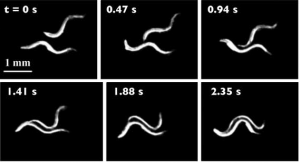Last week (8-12th August) saw the 5th European postgraduate fluid dynamics conference (EPFDC-2011) take place in Goettingen, Germany. The conference was jointly hosted by the Institute of Aerodynamics and Flow technology and the Max Planck Institute for Dynamics and Self-Organization. Organised by postgraduate students, the conference is an open-forum for PhD students allowing them to present their results in talks and posters to an audience of their peers.
The sessions were wide ranging in their themes, which included turbulent flows, applied aerodynamics, hydrodynamic stability and geophysical flows. The conference also featured talks on the swimming of micro-organisms, biofluid dynamics and the patterning of polymer melt films.
The hydrodynamics of swimming micro-organisms
Douglas Brumley is a PhD student at DAMTP, University of Cambridge. His talk focused on his work on the low Reynolds number swimmer Volvox carteri. Volvox forms spherical colonies of up to 50,000 biflagelated cells. The cells on the surface of the colony beat their flagella in a coordinated fashion, resulting in a net fluid motion around the colony. Various pictures and videos of the flagella and fluid motion can be found on the DAMTP website. Brumley’s work focuses on modelling the flow fields around the Volvox colonies and characterising the metachronal wave propagating on its surface.
Recent publications in Soft Matter on similar low Reynolds number swimmers include: Hydrodynamic synchronization at low Reynolds number doi: 10.1039/C0SM01121E, The collective motion of nematodes in a thin liquid layer doi: 10.1039/C0SM01236J and Swimmer-tracer scattering at low Reynolds number doi: 10.1039/C0SM00164C.
Flow through shunts at low Reynolds number
Adriana Setchi is currently a PhD student at Imperial College London. In her talk Setchi discussed her work on the modelling of flow in shunts in the small intestine. Shunts are used by doctors in the small intestine to by-pass diseased areas, or to shorten the intestine for weight loss. While medical doctors are able to carry out the implantation of shunts effectively, the dynamics of flow in these by-passes are not well understood. To model the flow, Setchi finds solutions to the Papkovich-Fadle-eigenfunction and applies them to various flow scenarios.
Recent publications in Soft Matter on dynamics in the small intestine include: The adsorption and competitive adsorption of bile salts and whey protein at the oil-water interface doi: 10.1039/C1SM05840A, Transitions in the internal structure of lipid droplets during fat digestion doi:10.1039/C0SM00491J.











